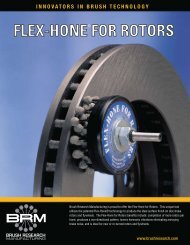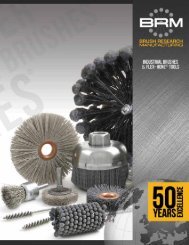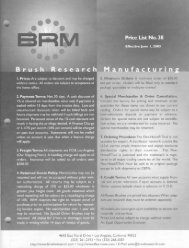Common Practices In CYLINDER BORING, HONING, AND WALL ...
Common Practices In CYLINDER BORING, HONING, AND WALL ...
Common Practices In CYLINDER BORING, HONING, AND WALL ...
You also want an ePaper? Increase the reach of your titles
YUMPU automatically turns print PDFs into web optimized ePapers that Google loves.
THIS NEXT ONE IS SOMETHING ELSE…<br />
I traveled to a repair shop that rebuilds and repairs high performance foreign<br />
cars and picked up a used three stone hone. Also the owner has his own<br />
race car. He apologized for this hone; as well he should. He explained that,<br />
“I now use the Flex-Hone.” So maybe we can forgive him a little. One<br />
stone broken and the other cracked. The faces of the stones were about as<br />
flat as a golf-course. It would be a little ridiculous to measure them. But,<br />
brother, what they would do to a cylinder wall. It is amazing how many<br />
shops use devices just like this one…without a second thought.<br />
(Below)A traditional two stone<br />
rigid hone.<br />
A taper of more than .012 (.3048 mm) probably will have oil escape under<br />
the rings (opposite the thrust side) and may also have blow-by and will<br />
damage the rings.<br />
However, some companies say that if the taper is not more than .007 to<br />
.009 that the cylinder walls should be deglazed.<br />
The problem is that if you have a cylinder, glazed and tapered .005” and<br />
you use a rigid hone, by the time you have the wall de-glazed you have<br />
probably had to remove so much metal so as to make the cylinder unusable.<br />
You might have to remove as much as .005”. The end result is a cylinder<br />
that is dangerously close to having serious problems immediately, and very<br />
well could develop them quickly.<br />
The Flex-Hone, however, contours itself to the cylinder and deglazes it,<br />
puts in the proper crosshatch with almost no stock removal (.0005”).<br />
Furthermore, if you have a carbon, or metal ridge from ring wear which you<br />
have to remove with a ridge reamer, the rigid stone will have a difficult time<br />
getting your proper finish at this point. The Flex-Hone gets easily “under”<br />
the ridge to ensure proper contact between ring and wall.<br />
RING SEATING<br />
Position 1 2 3<br />
High side of “A” stone .595” (15.113 mm) .595” (15.113 mm) .593” (15.062 mm)<br />
Low side of “A” stone .552” (14.021 mm) .552” (14.021 mm) .552” (14.021 mm)<br />
High side of “B” stone .606” (15.392 mm) .605” (15.367 mm) .602” (14.275 mm)<br />
Low side of “B” stone .562” (14.275 mm) .562” (14.275 mm) .562” (14.275 mm)<br />
TAPERED <strong>CYLINDER</strong>S<br />
Figure 5<br />
Figure 6<br />
Before we created the Flex-Hone, people would often say that a rough<br />
surface of friable material has to be left for the rings to work on or else the<br />
rings won’t seat.<br />
The need to “break-in” your cylinders arises from the surface finish that is<br />
generally accepted at the manufacturing level. The cylinders are usually<br />
finished with a very sophisticated diamond hone which cuts extremely<br />
well. The problem, however, is that the finish, while precise, leaves a lot<br />
of “proud” metal, or small peaks in the finish. The break-in process wears<br />
these away until they become the desired plateaued finish. The problem is<br />
that the wearing down is done by the piston and ends up wearing the rings<br />
and decreasing the life of the engine.<br />
The Flex-Hone does it better and faster. By finishing the cylinder wall with<br />
the Flex-hone for 30 seconds, we can do what might take the rings 500-<br />
1000 miles (800-1600 km) to do, while saving unnecessary wear on the<br />
rings. Our users say that they get “instant ring seating.”<br />
We tell them, “Well, almost instant.” It does take a few seconds to use the<br />
Flex-Hone.<br />
Another benefit of having the Flex-Hone finish the cylinder is lowered oil<br />
consumption because of its superior finish.<br />
A worn cylinder. Worn more at the top of course, with<br />
the taper GREATLY exaggerated.





